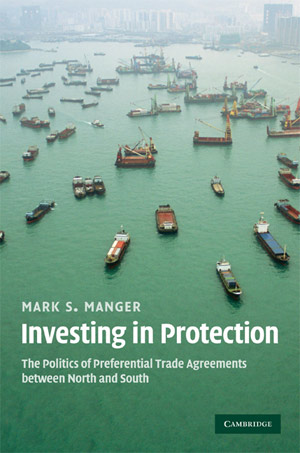
One of the most notable developments in international trade after the end of the Cold War has been the explosion of preferential trade agreements (PTAs). In 1990, there were about two dozen. Today, we are looking at several hundred, with many more under negotiation. PTAs come under various names and guises—free trade agreements, economic partnership agreements, regional integration agreements—but they have in common that they liberalize trade barriers between their members only. They are also the only legal exception to the rule of non-discrimination in the World Trade Organization (WTO), the legal principle that is supposed to put all members on equal footing.
Just as striking as the rapid growth of PTAs is that the majority today are North-South agreements. The North American Free Trade Agreement (NAFTA) was the first of this kind of trade deal that spanned the North-South divide.
Yet “trade agreement” is actually a misnomer. Investing in Protection argues that North-South agreements are much less about exports and much more about foreign investment. In fact, negotiators from the North often go to great lengths to exclude large shares of trade between the partners. They also try to delay the reduction of their own tariffs as much as possible, especially for goods from the developing country partner that threaten jobs in the North. In contrast, barriers against foreign investment and the trade closely related to it are eliminated rapidly.
The actors behind this story are multinational firms. In manufacturing industries, they move production into developing countries where labor costs are lower. In the services sector, they buy up recently privatized assets in order to enter markets. Because they provide jobs in both countries, they have greater influence over politicians than labor, consumers, and even conventional exporters.
Politicians and multinational firms therefore strike a bargain. Given the differences in wage levels, any North-South agreement is politically difficult: It threatens to move jobs offshore, and it might open a backdoor to competitors to enter the home market. For example, during the NAFTA negotiations, many US firms were afraid that European and Japanese competitors would build factories in Mexico and sell into the US market. Most PTAs are therefore written to include various barriers against outsiders, from obscure “rules of origin” to different standards and regulations.
This in turn has an unintended consequence: Those who are excluded lobby for their own agreements to level the playing field. Following NAFTA, the European Union and Japan moved to establish trade agreements with Mexico. North-South PTAs create a competitive dynamic that draws in ever more countries into the trend toward discriminatory trade.
“North-South agreements are much less about exports and much more about foreign investment.”
The idea for the book was born from a conversation with Noboru Hatakeyama, a former top official in Japan’s Ministry of International Trade and Industry—the (in)famous MITI—in the fall of 2002. I had just arrived in Japan with a completely different research project in mind, but found that the foreign policy establishment was wholly occupied with the free trade agreements that Japan had just started to negotiate. Hatakeyama was one of the key figures in promoting the new policy.
Since the end of the US occupation, Japan had relied on multilateral trade institutions, avoided any preferential agreements, and only reluctantly negotiated bilaterally with the US, which were worried about the strength of Japanese exports in the 1980s. Now Japan turned its policy completely around, engaging in a flurry of bilateral negotiations. The driving force behind this change was a realization that Japanese firms were strongly discriminated against in their activities abroad. Seen from Japan, NAFTA appeared almost purposefully designed to make it hard for the likes of Nissan and Panasonic to operate in Mexico.
It was an exciting time to be in Tokyo, and I spent the next six months running from meetings with trade officials to workshops with academics to interviews with company and trade association representatives. Some of the work was more like investigative journalism than social science research. In Japan, the private sector prefers to let the government take the lead; getting the unofficial version of a policy is often hard.
Because of this reluctance to discuss views publicly, especially with foreigners, and because the English-speaking, urbane, elite bureaucrats are much more accessible, many at the time thought that Japan’s trade agreements were a government-driven project. But once I scratched the surface of this new strategic policy consensus, I came upon a fierce battle between different interest groups whose strategic priority was their own material gain. In short, despite a different institutional and cultural context, it was a way of policymaking that any observer of US politics would immediately recognize.
This allowed me to extend the study into large, comparative framework. It turns out that North-South PTAs follow a similar pattern, whether the powerful party is Japan, the US, or the EU. The developing country usually swallows whatever is offered in return for the promise of more foreign investment, or the veiled threat that others are standing in line ready to sign their own deal. In the book, I analyze the cases of NAFTA, the EU-Mexico and Japan-Mexico FTAs, the agreements that the US and the EU have negotiated with Chile, and the “Economic Partnership Agreements” that Japan has sought with Thailand and Malaysia.
Approaching the analysis through such qualitative case work has its risks. It seems almost a universal rule of human behavior that whenever we pursue our naked self-interest, we justify it with reference to the greater social good. Politicians and lobbyists have mastered this to the point where they believe their own words—turning them into what Marx called “character masks.” For the researcher, this means that we can never take statements at face value and must avoid asking for motivations, and instead trace decisions and identify critical junctures. In short, we must objectify our subjects, and ask if our theories predict their actions rather than their words. But doing so also gives us a much deeper insight into the policy-making process than looking for statistical correlations.
I’ve developed an analytical framework in which politicians and bureaucrats mainly respond to demands from economic interest groups in deciding trade policy. Institutions and culture do matter, but only idiosyncratically. Ultimately, it is economic self-interest that plays out in the political arena.
The book traces the pattern of the negotiation of several trade agreements. The substantive chapters devote much space to the political struggles that ultimately define the design of an agreement. Trade policy seems like a dry subject, but for the people involved, livelihoods are at stake, giving the process a surprisingly colorful and emotional character. Political action ranges from sit-ins in front of Japanese Ministries to attempted self-immolation by Korean farmers to the heartwarming invitation offered to trade bureaucrats to visit a pig farm to see the plight of farmers with their own eyes.
The Japanese cases are particularly interesting. Their first trade agreement was signed with Singapore, who conveniently had almost no trade barriers. And yet, even here, agricultural protectionism almost led to a failure of the negotiations, because Singapore exports aquarium goldfish. Although the negotiations with Singapore were just supposed to be a gentle trial run, they already foreshadowed the intense resistance that an FTA with Mexico would run into. The sensitive issue is almost always agriculture. But given the asymmetries between the partners—Mexico still needed Japanese investment more than Japan needed Mexico as a production site—the most competitive exports from the developing country are often excluded from the deal.
Clearly, preferential trade agreements are often brought about at the behest of a very narrow range of actors. The EU-Mexico agreement was first and foremost a deal to protect the interests of one multinational firm—Volkswagen—and its chain of suppliers. Volkswagen is not only an industrial giant in Europe, but also one of the biggest employers in Mexico. Although present in Mexico since the 1960s, the company found itself at a severe disadvantage once NAFTA had come into force. Mexico had previously offered a variety of tariff benefits to foreign manufacturers, but in the NAFTA negotiations, US trade officials had managed to have all of these banned and new barriers erected. The primary targets were Japanese and European manufacturers. Volkswagen supported an FTA to counter these measures, and largely succeeded. But neither European nor Mexican exporters gained much additional access to the other’s market.
The characters that emerge as heroes in these cases are often the developing countries’ negotiators. Chilean and Mexican trade officials can hold their own against any highly-paid Washington lawyer or école nationale—trained European Commission official. Nonetheless, what they can achieve is severely limited by their country’s relative position in the global economy.
“North-South PTAs create a competitive dynamic that draws in ever more countries into the trend toward discriminatory trade.”
The integration of developing countries into the world economy is a defining feature of globalization, and North-South trade agreements are where much of this plays out. For some, these trade agreements are a path to economic development after the policies of import-substitution have failed. But as politics and power intrude, the benefits that economic theory promises are hard to obtain. With this in mind, many critics of globalization have set their aims on the WTO. My book shows that the WTO is almost a sideshow by now, compared to these countless preferential agreements. But for developing countries, the WTO actually promises greater economic gains. What’s worse, by satisfying the interests of multinational firms, these bilateral deals actually erode the political support for broader, non-discriminatory free trade.
Talk of BRICs (Brazil, Russia, India, China) and the decline of the West aside, the global economy is still characterized by stark asymmetries of power. It is not economic globalization itself but the politics of it that reinforce these asymmetries. North-South agreements reflect this. They are primarily a competition between economic giants. Yet with this insight, we can start to think about solutions that spread the economic gains more widely.


Mark S. Manger is a Lecturer in the Department of International Relations at the London School of Economics, where he teaches in the International Political Economy program. He previously taught at McGill and was a fellow in the Harvard US-Japan program. His research focuses on North-South relations, with a particular interest in the Asia Pacific region. His work has been published in World Development and the Review of International Political Economy. Despite his schooling in a positivist political science and economics tradition, he still catches himself thinking Marxist thoughts from time to time.